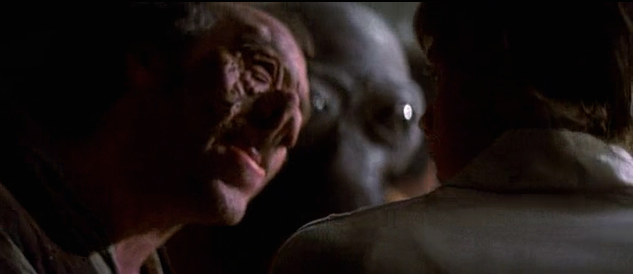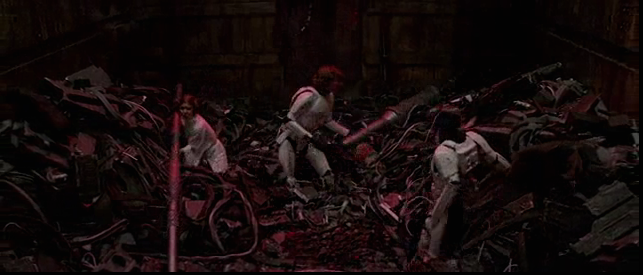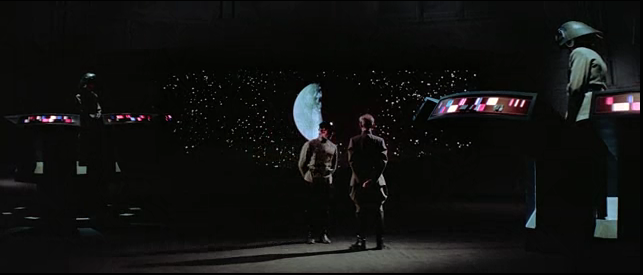One of the main motivations, which prompt people to read fiction-novels and to watch movies, which contain the motifs of otherworldliness, is the fact that, while being exposed to these literary and cinematographic works, individuals are being often able to confirm the validity of their unconscious anxieties, as to what accounts for the true essence of a surrounding reality.
In its turn, this usually helps people to attain the sensation of an ‘existential wholesonmess’ – when they come in a close touch with a number of socially suppressed truths about what may be considered the actual significance of their life-experiences.
The Freudian concept of ‘uncanny’ comes in particularly handy, when it comes to discussing the significance of fictitious representations of otherworldliness, “An uncanny experience occurs either when infantile complexes which have been repressed are once more revived by some impression, or when primitive beliefs which have been surmounted seem once more to be confirmed” (Freud 57).
Therefore, it makes a perfect logical sense to discuss these representations as such that are being reflective of the workings of people’s unconscious psyche. In this paper, I will aim to do just that, in regards to the motifs of otherworldliness, which can be found in George Lucas’s 1977 film Star War: A New Hope and Steven King’s 1977 novel The Shining.
The foremost aspect of how the unworldly reality is being depicted in Lucas’s movie is the fact that, while being exposed to it, viewers are being prompted to establish dialectical links between what they get to see on the screen and what accounts for the essence of their socialization-related experiences, in a real life.
The validity of this statement can be well illustrated in relation to the film’s scene, in which the characters of Luke Skywalker (Mark Hamill) and Obi-Wan Kenobi (Alec Guinness) end up confronting aliens and mutated humans in the bar, on the planet of Tatooine (00.46.37).

There can be few doubts as to the fact that there are strongly defined motifs of the Freudian ‘uncanny’ to this particular scene, because it relates to the White viewers’ unconscious fear of multiculturalism.
After all, it does not represent much of a secret that even many open-minded Whites in Western countries, where the policy of multiculturalism had attained an official status, do not exhibit much of an enthusiasm, while being required to take an active part in the ‘celebration of diversity’.
Hence, their tendency to prefer residing in a racially secluded ‘white suburbia’, as opposed to residing amidst the representatives of racial minorities in ethnic ‘ghettos’.
Therefore, while exposed to the scene, in which the alien-looking representatives of an ‘intergalactic scum’ are picking upon the characters of Luke Skywalker and Obi-Wan Kenobi, many viewers confirm the validity of their rationally suppressed fear of venturing in places, where ethnically diverse individuals can be found in particularly large numbers.
There are two mutually exclusive aspects of how people experience the ‘uncanny’ – they are being simultaneously encouraged and discouraged to rationalize their unconscious anxieties, in regards to the potential dangers of the unknown.
Apparently, Steven King was well aware of it, which is why he used to say that it is being in the very nature of just about every individual to expect that even thoroughly conventional settings conceal subliminal horrors.
Therefore, it does not come as a particular surprise that King’s novel contains scenes, in which Danny’s otherworldly daydreaming becomes ‘uncanny’ to an extent that readers simply cannot help but having their attention solely focused on the plot’s unraveling – quite contrary to the fact that they do realize that what they are about to read may well scare them to death.
For example, there is a memorable scene in the novel when Danny is having a vision of streams of blood starting to pour down on the floor out of the elevator doors (King 161). This scene’s ‘uncanny’ appeal is being concerned with the fact that the author was able to take a certain advantage of the readers’s subliminal tendency to associate the color red with blood.
Therefore, even though readers do get to experience a certain horror, while being exposed to this scene, on an unconscious level, they nevertheless do not perceive the concerned plot’s twist as being thoroughly unrealistic. This is because, prior to having this vision, Danny stared at the red-colored elevator doors for a long time. Yet, the prolonged staring at ominously looking red doors can never bring any good – people’s unconscious psyche never ceases being aware of it.
The fact that the portrayal of otherworldly spaces in movies serves the purpose of prompting viewers to come to terms with their fear of the unknown can also be explored in regards to another scene in Lucas film, in which Luke Skywalker, Princess Lea (Carrie Fisher) and Han Solo (Harrison Ford) find themselves trapped in the Imperial spaceship’s garbage-compartment (01.21.43).

While there, they realize that is a some kind of dangerous creature is lurking underneath the murky water. Yet, even though that a good part of the concerned action involves all three characters trying to figure out what they are being faced with, the creature never shows itself.
The only part of this creature that viewers get to see is its tentacle. This, of course, results in the intensification of viewers’ fears of the unknown even further, because it is specifically the unknown types of danger, which people tend to perceive as being particularly dangerous.
It appears that by exposing viewers to this particular scene, Lucas was able to strengthen the acuteness of their ‘uncanny’ experiences, which in turn increased the film’s cinematographic appeal rather dramatically – in full accordance with Freud’s outlook on the subject matter.
The same can be said about the scene in King’s novel, in which Danny realizes the fact that his nightmares of being chased by a person with an ax in his hands were bound to come to reality, “It was the place he had seen in the midst of the blizzard… The place Tony had warned him against. It was here. It was here. Whatever Redrum was, it was here” (69).
The clearly ‘uncanny’ undertones to Danny’s earlier mentioned realization are being thoroughly apparent, because the author made a deliberate point in emphasizing the unknown subtleties of Redrum, which in turn increased the extent of this scene emotional intensity.
Apparently, King wanted readers to remain in the state of suspense, for as long as possible. This is the reason why, every time the novel’s characters come in a close touch with the emanations of otherworldliness, they can never they can never grasp the true significance of their experiences, in this respect.
The manner in which Freudian ‘uncanny’ is being explored in movies that contain strongly defined otherworldly motifs, often serves the purpose of allowing viewers to experience the sensation of Déjà vu. In its turn, this strengthens the extent of their commitment to perceiving the plot’s unraveling as such that does in fact relate to their own positioning in life.
For example, there are a number of scenes in Lucas’s film, in which Imperial officers act in a particularly cold-blooded manner, while refusing to consider other people’s feelings. These scenes, of course, were meant to trigger in viewers the same set of emotions that they get to experience, while reflecting upon the historical legacy of Nazi Germany.
Therefore, it is not a pure coincidence the Imperial officers’ uniforms resemble those that used to be worn by Nazis – especially riding breeches, as seen on the screenshot below.

Apparently, the director did strive to prompt viewers to construct their attitude towards the representatives of the ‘dark side’, in regards to what accounted for the discursive significance of Imperial soldiers’ physical appearance and the qualitative essence of their psychological inclinations.
In its turn, this explains the popularity of this film’s most otherworldly character – Darth Vader. Even though that, throughout the movie’s entirety, Darth Vader rarely talks, viewers nevertheless are able to get a good clue, as what kind of an individual he really is.
The reason for this is quite apparent – despite the character’s otherworldly appearance, people can well recognize him as a person who represents currently suppressed (due to considerations of political correctness), but discursively legitimate masculine virtues of loyalty and cold-heartedness.
Essentially the same line of reasoning can be applied, when it comes to discussing the significance of Déjà vu–invoking scenes in King’s novel, concerned with otherworldliness. The scene, in which the character of Jack Torrance walks in the ballroom, filled with the ghosts of people that were alive during the Great Depression, exemplifies the point.
This is because, the appearance of these ghosts (or mental constructs, which existed solely within Jack’s brain) cannot be discussed outside of the fact that the era of the Great Depression has been traditionally associated with the notion of moral depravity, “A woman in gauzy harem pants and a rhinestone-sparkled brassiere, a man with a foxhead rising slyly out of his evening dress, a man in a silvery dog outfit who was tickling the nose of a woman in a sarong with the puff on the end of his long tail” (405).
What it means is that, even before Jack turns into a bloodthirsty psycho, the earlier mentioned scene provided readers with an unconsciously-felt indication that this eventual development was indeed bound to occur.
Apparently, while being prompted to construct images of fancifully dressed people drinking and laughing, readers get to experience a Déjà vu sensation that there is something utterly short-lived about these partying individuals.
After all, on an unconscious level, we all know that the intensity of a particular sensual pleasure corresponds to the extent of this pleasure’s lengthiness in a counter-geometrical progression. Thus, the portrayal of an otherworldly space in this particular scene was meant to confirm the validity of readers’ growing suspicion that Jack was actually on the path of a mental self-destruction.
Works Cited
Freud, Zigmund. The Uncanny, London: Penguin Books Limited, 2003. Print.
King, Steven. The Shining, New York: Gallery Books, 2002. Print.
Star Wars Episode IV: A New Hope. Ex. Prod. George Lucas: 20th Century Fox. 1977. DVD.